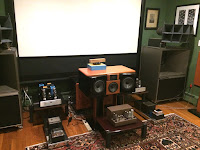Top Pic: (Case 2) Pic of R's A5 System as of now. My Bell 6V6 amps in center front. Compare with old photo below.
Talk Horn: In-Room Placement, A Tale of Two Horn Systems
HiFi Basics VII: Loudspeaker Placement - Close-to-Wall vs In-Room
McIntosh C-20 Preamp, MC-30 A
Significant Update Oct 5, 2018: Subwoofer Supplementation added. Update shaded in Grey.
Although we are illustrating with big horn systems the size of refrigerators here, I believe the principals are universally applicable, to much smaller loudspeakers, including bookshelves.
There is little question loudspeaker placement is of the utmost importance in a system. Previously, in
HiFi Basics III, I detailed my own encounters of Short vs Long Walls. This article examines Close-to-Wall vs In-room Placements.
Close-to-Wall Placement By Design FEW modern loudspeakers are designed to be placed against the wall, as this intrinsically is at odds with the modern hifi values of maximizing imaging and soundstage. But there are a few dedicated designs, like the very good Linn Kan, which needs the wall reinforcement to have useable bass for most people. More recently, there is the Wilson Audio TuneTot, which receives a lot of coverage from the audio press, but to me it is a ridiculously expensive product for what it is, and showcases the utterly hopeless nature of high-end reviewers (The TAS is a particularly serious offender; their eulogies on the passing of Wilson Sr make my flesh creep
簡直肉麻!)
Corner Placement This only applies to certain vintage loudspeakers, usually larger horn systems with specifically designed corner cabinets (Klipschorn and Tannoy's) to optimize bass output. The corner has two reflecting surfaces which would cause even greater havoc with most other loudspeakers.
By Choice/No Choice Sometimes one has no choice but to place loudspeakers against the wall. In my experience, most loudspeakers sound suboptimal to terrible thus placed. Most would suffer from badly delineated bass and lack of air.
In this situation, one would be wise to choose infinite baffle (sealed) enclosures, preferably those with monitor pedigree, as these usually work well in near field situations and have good but never exaggerated bass. As an example, my large Yamaha NS-1000 works beautifully against the wall; there is still a good soundstage and imaging (though not as good as in-room), and my TAD TD-3401 is also good in this way. Ported loudspeakers, even front-ported, do less well.
Klipsch Heresy This unusual loudspeaker is actually stipulated to be used (on its own pedestal) against the floor, not the wall, but that is not that different. Without floor reinforcement, the Heresy is lean in the bass. As such, it actually works well close-to-wall.
How should Horns be placed? No doubt the size factor predisposes their owners to put them against the back (front) wall. Also, the ungainly, industrial and utilitarian appearances of many horn systems, such as the Altec's in this article, certainly do not earn them admiration from family members and that is another incentive for relegating them to the back, even in the corners. For many, it just has to be that way,
BUT for those who have the room, that is a mistake.
These horns were originally used in large theaters, perhaps hanging, but usually not against the wall; and firing down a huge space (ample space around them) minimizes any anomalies. In our much smaller spaces, one needs to take care.
In my old place in HK, I had my Tannoy Canterbury's (large loudspeakers with small horns) and TAD TD-3401 half way in-room and they sounded great that way. Visitors were always amazed by the depth of soundstage and, even more, the disappearance of the loudspeakers. In NYC, I have my YL horns the same way, with similar results. Like with a lot of more conventional loudspeakers, unless restricted by bass nodes,
I like the loudspeakers in-room and with the listener form close to an equilateral triangle. Some would call this near-field, or nearly so, and it should lessen boundary effects. For me, in both HK and NYC, the sweet spot for loudspeaker placement is largely the same for all sorts of designs.
Subwoofer Supplementation What a Difference a Little makes There are many purists out there who are adamantly against subwoofers, but these are mostly people who have little concept of what live music is like. Our hearing is a complicated thing - without a bass foundation not only will the midrange and upper frequencies sound leaner, but the music will lack true sparkle, which most audiophiles mistake to lie solely in the treble. The best example is my friend WSS' Quad ESL, which came to life with just a whiffle of low bass added (here). I always tell people, a little augmentation does not really augment the bass by much, but helps the overall picture, to bring things to life. As in the case of WSS, the important thing is less to hear the difference, but to feel it. When to Use? This is purely by hearing. My modern Tannoy Canterbury, TAD TD-3401 and YL horn system (with Altec 216 woofers) do not need help, but my JBL 4312 and my NYC friends' Altec A5/A7 systems absolutely do. Another case is my Klipsch Heresy, which really is severely limited by its original design (on the floor), but rather should be used "normally positioned," together with a subwoofer (detailed here). Subwoofer vs Other Means When the bass is lean, the problem can lie with the loudspeakers, the equipment or simply the room. Audiophiles have many ways to increase bass, but these should only be used judiciously, as the "remedy" is often worse than the problem. It is one thing to try, e.g., Mogami instead of Gotham (both cheap professional cables with balances close to neutral, though they sound different), it's another to use expensive boutique cables that are basically highway robbery. Case in point: Thick and stiff cables, e.g. NBS, often increase bass, but are highly colored and smear everything. Most of the time, the loudspeaker is the real limitation - it would be wise to spend time dialing in a subwoofer rather than make the bass "fuller" via other means, as one really wants more true extension rather than bumping up the mid-bass.
The owners of these two Altec systems are good friends of mine who should be familiar to regular readers of this blog. Both share a passion for music as well as many other non-musical things, such as cooking! Both are lucky to have a dedicated room. Both had their horns in the back
until I came back this time. Both had their horns on wheels so it was
relatively easy to move the behemoths forward. As they say, the rest is history.
 Pic shows (Case 1) Kevin's A7 System, now way out in front (compare with old photo below). The turntable on the Wall Mount is now a restored Lenco G-75 (VPI relegated to the left, a corner of which can be seen behind the B&W CM5). Below are newly acquired and restored McIntosh MC-30's. On the front stools is one of my C-20's. Click to enlarge.
Pic shows (Case 1) Kevin's A7 System, now way out in front (compare with old photo below). The turntable on the Wall Mount is now a restored Lenco G-75 (VPI relegated to the left, a corner of which can be seen behind the B&W CM5). Below are newly acquired and restored McIntosh MC-30's. On the front stools is one of my C-20's. Click to enlarge.
 L pic shows the Dumpling Dinner with side dishes of Pork stewed with Dried Bamboo Shoots, Braised Peanuts and Sliced Smoked Turkey; R pic shows the older against-the-wall Placement. Also roll down to the Blog entry before this one.
L pic shows the Dumpling Dinner with side dishes of Pork stewed with Dried Bamboo Shoots, Braised Peanuts and Sliced Smoked Turkey; R pic shows the older against-the-wall Placement. Also roll down to the Blog entry before this one.
 Case 1: Altec A7
Case 1: Altec A7
Since I last wrote about K (roll down to previous post) I have visited him two more times. Unbelievably efficient, over a short time he managed to move the horns forward and clear up the central clutter. All gears are now well behind and there is a clean line of sight to the plane of the loudspeakers.
The sound is totally freed up. As the man himself said, the sound now emanates from the space in front, rather than from the loudspeakers. I cannot agree more, and this also met with the approval of our captain Andy. Now, with the much cleaner and focused sound, Francescatti's tone (which could be grating in lesser systems) in his classic recording of Beethoven's Violin Concerto with Bruno Walter was just marvelously sinuous. Thumbs up! Credit is also due to K's DIY WE cable.
We also really liked the the full McIntosh combo, the Lenco/Decca/Shure M44-7 playing straight into the C-20's phono and driving the MC-30 pair. Everything sounded just right.
 Case 2: Altec A5
Case 2: Altec A5
Then we visited R (
last visit). I have long suggested to relegate the HT system to the periphery and bring the horns forward. I was surprised that R was game and K carried it out single-handedly (he definitely earned his lunch)! It was quite a bit of work! Everything was dismantled (the Cary amps were heavy!), the huge HT subwoofer exchanged its space with the large HT center. The result was again a cleaner path to the plane of the loudspeakers.
The effect was much as at K's place, a cleaner sound that is free of the enclosures. The Bell 6V6 amps worked very well in this system. Marvelous!
And the Food!
 Book Review: Maestros and their Music
Book Review: Maestros and their Music




















